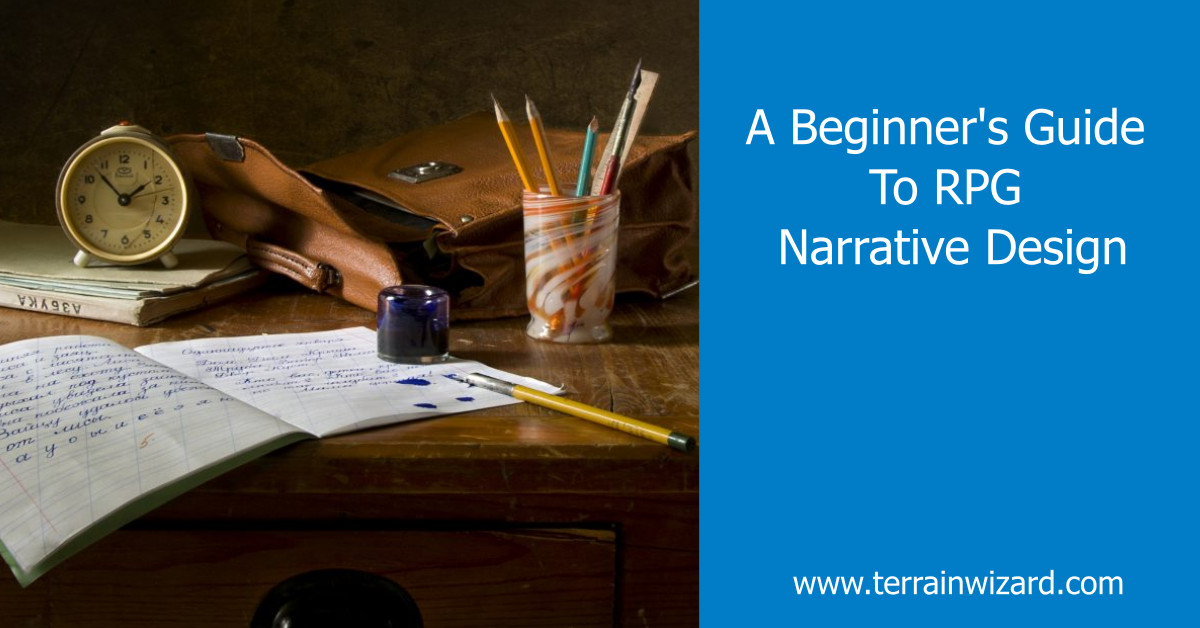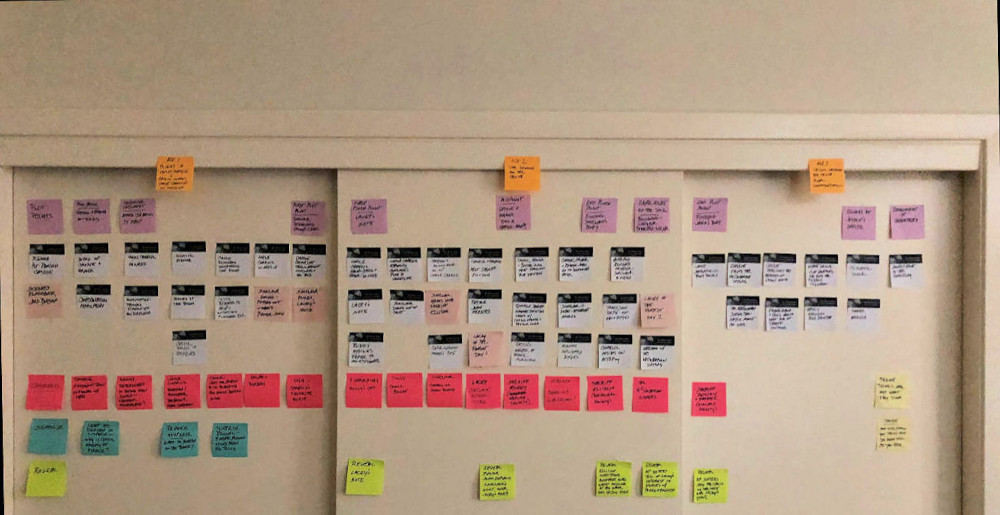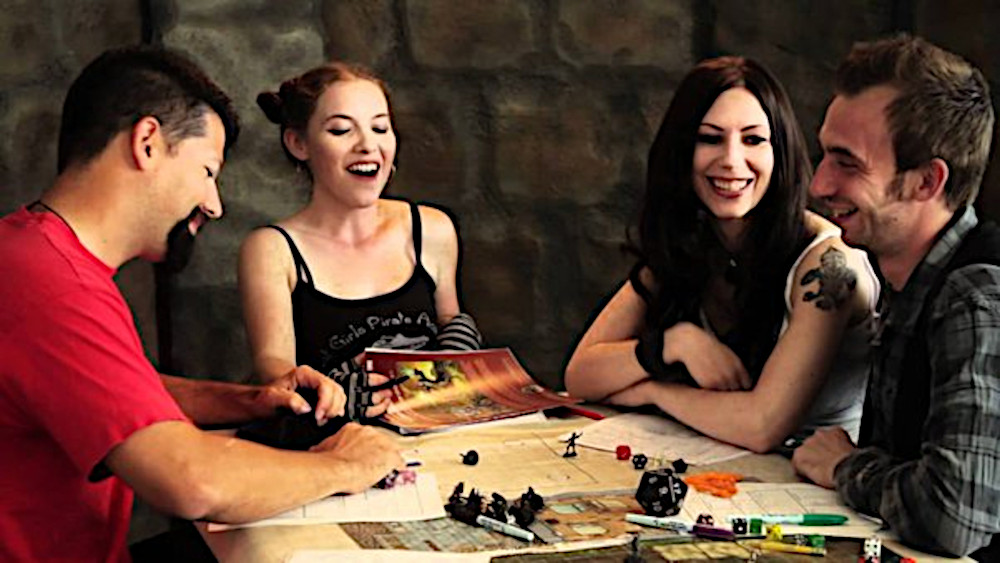Your cart is currently empty!
A Beginner’s Guide To RPG Narrative Design

Narrative design is the foundation of a successful tabletop RPG. Mastering this skill is essential for any designer wanting to create immersive, memorable experiences for their players.
At their core, tabletop RPGs are all about the stories we tell. Narrative design is the key to crafting unforgettable experiences for players. Understanding how to create compelling encounters that advance the adventure’s plot or reveal critical information about the game world is essential. Equally important is knowing how to seamlessly integrate these encounters into a larger campaign to ensure the narrative stays on track and remains thematically consistent.
Creating a story that is thematically appropriate for the game world and aligns with the character’s goals and motivations is crucial to achieving a successful narrative. However, this can be challenging, especially for new designers still learning the ropes.
In this beginner’s guide, we will explore some of the core principles of narrative design. We will delve into the key principles that underpin compelling storytelling in tabletop RPGs. We will also present actionable tips and strategies you can implement in your games. As a result, you can captivate your players, who will keep returning for more.
Contents

Craft a Compelling Story
Tabletop RPGs are a unique gaming form that relies heavily on storytelling and immersion. As a narrative designer, your job is to create a world that feels real, characters that players care about, and a story that engages them from start to finish.
Define Your Narrative Structure
Every story needs a structure to give it direction and purpose. In a tabletop RPG, this means defining the story’s beginning, middle, and end. You will also need to create an overarching goal or objective that players work towards. This structure should be well-planned and cohesive, with each narrative element contributing to the plot.
However, it’s important to remember that the structure should be flexible. Players should be free to explore and interact with the world in their way, so the narrative should be flexible enough to allow for that. It’s a balancing act between providing a clear direction and allowing for player agency.
Develop Memorable Characters
Characters are the heart of any story, and tabletop RPGs are no exception. Players should care about the characters they’re playing and the characters they encounter in the world. This means creating three-dimensional characters with unique backstories, motivations, and personalities that players can relate to and engage with.
As the narrative designer, it’s crucial to ensure that each character serves a purpose in the story and contributes to the plot. Characters should have their own goals and objectives relevant to the story. Plus, their actions should have consequences that affect the players and the world around them.
Build a Rich and Detailed World
The game world is just as important as the characters that inhabit it. A rich and detailed world with a history, geography, and culture that players can explore and interact with is essential to creating an immersive experience.
As the narrative designer, it’s your job to create a world that feels alive and dynamic, with hidden secrets and mysteries to uncover. Players should feel like they’re part of the world. Their actions should have a tangible impact on the world around them.
Offer Meaningful Player Agency
One of the hallmarks of tabletop RPGs is player agency. Players should be able to make meaningful choices that affect the story’s outcome. However, ensuring those choices are relevant, challenging, and engaging is essential.
The narrative designer should create a story that offers players a sense of control over their destiny, with choices that have immediate and far-reaching consequences. Players should be able to explore different paths and make decisions that align with their character’s motivations and objectives.
Control Pacing and Tension
Finally, the pacing is critical in narrative design. The narrative designer should be able to control the story’s pace and tension to create a satisfying player experience. This means balancing moments of intense action and conflict with periods of rest and reflection.
The narrative designer should also be able to adjust the pacing to suit the players’ needs. If players seem disengaged or bored, it may be time to ramp up the action. On the other hand, if players seem overwhelmed or stressed, it may be time to ease up and let them catch their breath.

Encourage Player Agency
Tabletop RPGs are unique in allowing players to make meaningful choices that affect the story’s outcome. Player agency refers to the player’s ability to make decisions that impact the game world and the story.
When players feel like their choices matter, they become invested in the game and the story. This leads to a more immersive and satisfying experience for everyone involved.
Let’s explore some practical ways to create it in your tabletop RPGs.
Give players meaningful choices
One of the more effective ways to create player agency is to give players meaningful choices. These choices should have consequences that impact the story in significant ways.
For example, you could allow players to ally with one faction or another, with each option leading to different outcomes and consequences.
Create consequences for player actions
Players’ choices should have real effects that impact the game world and the story. These consequences could be immediate or delayed, positive or negative.
For example, suppose players choose to attack a powerful NPC. In that case, they may face retribution from that NPC or their allies later in the game.
Encourage creativity
Encourage players to be creative with their choices and actions. This can lead to unexpected and exciting outcomes, adding depth and complexity to the story.
For example, if players develop a unique plan to infiltrate an enemy stronghold, consider allowing it if it makes sense within the context of the game world.
Emphasize character development
Player agency is enhanced when players are invested in their characters. Encourage players to develop their characters’ backstories, motivations, and personalities. This will make their choices more meaningful and the consequences more impactful.
Balance challenge and fun
Balancing the game’s challenge and the experience’s fun is essential. Too much challenge can make players feel powerless, while too much fun can make the game trivial. By creating player agency, you can strike a balance between these two elements, ensuring that players feel both challenged and engaged.

Create Emotional Impact
Tabletop RPGs are about immersing players in a rich, engaging game world. Players want to feel like they are a part of something exceptional.
As game designers and game masters, we aim to create an unforgettable experience. In part, we create that experience through emotional impact. An excellent narrative design evokes emotions in players, investing them in the story and characters.
When players care about what happens in the game world, they are more likely to engage with it on a deeper level. Every decision they make carries more weight. They become invested in the outcome. This investment creates a more immersive and satisfying experience for everyone involved.
Here are some of the most commonly used techniques to engage players on a deeper level.
Character Backstories
A character’s backstory is one of the most powerful tools for creating emotional impact. A character with a compelling backstory has more depth and is more relatable to players. By giving characters a rich and meaningful backstory, players will become invested in their journey and feel more connected to them.
For example:
In “Tomb of Annihilation,” the players are tasked with exploring a dangerous jungle in search of a powerful artifact. Along the way, they encounter a tribe of goblins enslaved by an evil necromancer. By freeing the goblins and helping them reclaim their homeland, players create a sense of investment in the world and the characters they encounter.
Compelling Antagonists
A great villain can be a powerful motivator for players. When players have a stake in defeating the antagonist, every encounter carries more weight. Thus you create urgency in the game. You can elicit strong emotional responses by creating a villain everyone loves to hate.
High-Stakes Decisions
Players who face tough decisions with significant consequences are more likely to feel invested in the story. Players will become more emotionally invested in the outcome by creating choices that matter. High-stakes decisions can create tension and drama in the game, leading to memorable moments.
Memorable Moments
Unforgettable moments in the game can leave a lasting impact on players. Players will become more invested in the story and characters by creating moments that evoke strong emotions. These moments can be anything from a touching conversation between characters to a dramatic battle with a powerful foe.
For example:
In “Curse of Strahd,” the players are tasked with defeating the villainous Count Strahd von Zarovich. As they journey through the dark and foreboding realm of Barovia, they encounter characters struggling to survive in a world overrun by evil. These encounters create an emotional connection between the players and the game world, making the final confrontation with Strahd all the more impactful.

Construct an Immersive Setting
Crafting an immersive setting is critical to enhancing players’ overall experience. A detailed and engaging environment can draw players into the game world, stimulate their imagination, and make them feel invested in the story and characters.
Establish a Compelling Theme
Choose a theme that resonates with your players’ interests and preferences, whether high fantasy, sci-fi, horror, or something else. A strong theme ties together all elements of your setting, from geography and history to characters and conflict. This theme guides your world-building decisions and creates a cohesive, immersive game world.
Design Memorable Locations
Locations are the backbone of any setting. They should be designed to reflect the theme and mood of the game world. Start with critical locations essential to the story, such as a bustling city, a foreboding dungeon, or a mysterious forest. Develop these locations with attention to detail, including descriptions, maps, and unique features that make them memorable and engaging.
Create Compelling NPCs
Non-player characters (NPCs) can add depth and richness to your game world. They should be designed to reflect the theme and tone of the setting. Create NPCs with unique personalities, backstories, and motivations. Then let players learn from the interaction. NPCs can also offer quests, challenges, and plot twists that keep players engaged and invested in the story.
Integrate Lore and History
Lore and history can add depth and meaning to your game world. They create a sense of richness and complexity that players will appreciate.
Develop a rich backstory for your game world. Include historical events, legends, and myths players can discover and explore. Use this lore to create a sense of continuity and coherence, tying together the different elements of your setting.
Most importantly, it gives players a sense of purpose and meaning in their actions.
Offer Player Agency
Player agency is essential to creating an immersive setting. It allows players to feel like their choices matter and have a tangible impact on the story.
Offer players meaningful choices and consequences, allowing them to shape the game world and its characters. This can be done through branching paths, hidden secrets, and open-ended quests.
Make sure you let players explore the game world on their terms.

Fashion a Cohesive Narrative
Tabletop RPGs offer a unique storytelling experience where players take on the roles of characters in an immersive world. An outstanding narrative is more than the sum of its parts. The parts must work together to create an engaging and memorable experience for the players.
Consistency in World-Building
Consistency in world-building is crucial for a cohesive narrative design.
As a designer, you should establish a clear understanding of the game world’s lore, cultures, politics, and geography. This knowledge will help you integrate all game world elements into the story, making it cohesive and immersive.
When players encounter NPCs, artifacts, and events, they should feel like these elements belong in the game world and are consistent with the established lore.
Character Development and Motivations
Characters are the heart of any great story, and tabletop RPGs are no exception.
As a designer, you should encourage players to develop detailed backstories, motivations, and personalities for their characters. These elements should be integrated into the story, creating opportunities for players to confront and resolve their character’s issues.
As the story progresses, characters should experience growth and change, driven by their motivations and personal goals.
Conflict and Consequences
Conflict is essential to any story, including tabletop RPGs.
As a designer, you should create conflicts that are relevant and have consequences that affect the story and players’ experiences. When players make choices, these choices should have a meaningful impact on the narrative and the game world.
The consequences of their actions should be evident, whether it’s a town’s fate or a new enemy’s emergence.
Pacing and Tension
Pacing and tension are crucial elements of a cohesive narrative design.
As a designer, you should manage the pace of the story, balancing slower, more contemplative moments with faster, action-packed scenes. The tension should be carefully managed, building up to a satisfying climax that resolves the story’s conflicts.
When players encounter challenges or obstacles, tension should build up, leading to a climactic encounter that tests their skills and abilities.
Themes and Symbolism
Themes and symbolism add depth and meaning to a story, creating a sense of cohesion and purpose.
As a designer, you should incorporate themes and symbolism relevant to the story, characters, and game world. These elements should be integrated into the narrative meaningfully, creating a sense of resonance and purpose.
When players encounter themes and symbolism, they should feel like these elements add depth and meaning to the story.
Final Thoughts
Now you know the core principles that underpin compelling storytelling in tabletop RPGs.
Narrative design is the key to crafting unforgettable games. You should understand how to create compelling encounters. And you have learned the techniques which seamlessly integrate these encounters into a larger campaign.
Plus, you have various actionable tips and strategies to implement in your next narrative design. As a result, you can captivate your players, who will keep returning for more.
Explore Farther
Glue Stick Terrain is a great place to learn more.
